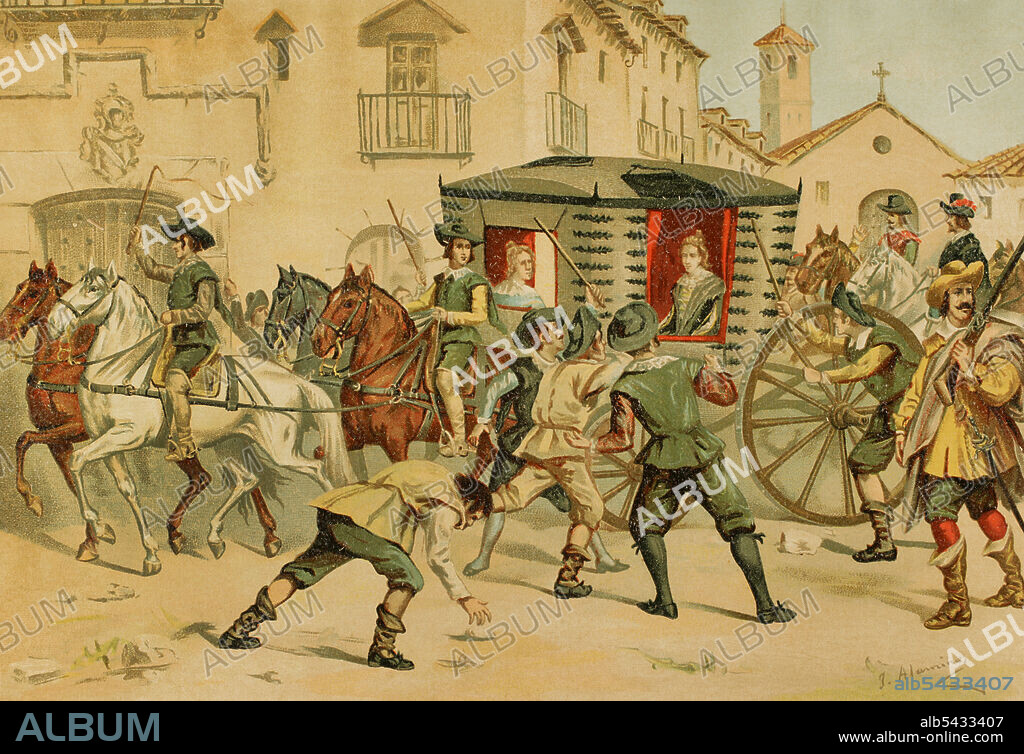alb5433407
JUAN ALAMINOS. SPANISH ARTIST OF THE SECOND HALF OF THE 19TH CENTURY.. Maria Anna of Neuburg (1667-1740). Queen of Spain, second wife of Charles II (between 1689 and 1700). After the death of Charles II it was decided that Mariana should take up residence in Toledo. At the end of June 1706 Charles III was proclaimed King of Spain in Toledo. Maria Anna of Neuburg decided for the first time to remove her mourning for the death of her husband and was honoured by the officers of the allied army. Charles III did not enter Madrid, so it was decided that Maria Anna should be forced to leave Spain as a matter of urgency, to prevent her figure from being used again by the imperialists. The Duke of Osuna, commanding a contingent of soldiers, was commissioned to Toledo to take her out of the city, on the pretext that for safety's sake it was better to send her away from possible places where war might take place. She was evacuated to Vitoria and then forced to leave Spain, choosing Bayonne as her final destination. Expulsion of the queen from the city of Toledo, on her way to Bayonne, France. Illustration by J. Alaminos. Chromolithography. "Historia General de España" (General History of Spain), by Miguel Morayta. Volume V. Madrid, 1891.

|
Ajouter à une autre Lightbox |
|
Ajouter à une autre Lightbox |



Avez-vous déjà un compte? S'identifier
Vous n'avez pas de compte ? S'inscrire
Acheter cette image.
Sélectionnez l'usage:

Légende:
Voir la traduction automatique
Maria Anna of Neuburg (1667-1740). Queen of Spain, second wife of Charles II (between 1689 and 1700). After the death of Charles II it was decided that Mariana should take up residence in Toledo. At the end of June 1706 Charles III was proclaimed King of Spain in Toledo. Maria Anna of Neuburg decided for the first time to remove her mourning for the death of her husband and was honoured by the officers of the allied army. Charles III did not enter Madrid, so it was decided that Maria Anna should be forced to leave Spain as a matter of urgency, to prevent her figure from being used again by the imperialists. The Duke of Osuna, commanding a contingent of soldiers, was commissioned to Toledo to take her out of the city, on the pretext that for safety's sake it was better to send her away from possible places where war might take place. She was evacuated to Vitoria and then forced to leave Spain, choosing Bayonne as her final destination. Expulsion of the queen from the city of Toledo, on her way to Bayonne, France. Illustration by J. Alaminos. Chromolithography. "Historia General de España" (General History of Spain), by Miguel Morayta. Volume V. Madrid, 1891.
Personnalités:
Emplacement:
Collection privée
Crédit:
Album / Prisma
Autorisations:
Modèle: Non - Propriété: Non
Questions sur les droits?
Questions sur les droits?
Taille de l'image:
5079 x 3475 px | 50.5 MB
Taille d'impression:
43.0 x 29.4 cm | 16.9 x 11.6 in (300 dpi)
Mots clés:
ARMEE: SOLDATS • BUGGY • CALECHE • CASTILE-LA MANCHA • CHARRETTE A CHEVAL • COLLECTION PRIVÉE • COULEUR • ESCORTE • ESPAGNE • ESPAGNE, HISTOIRE • EUROPE • GUERRE DE LA SUCCESSION D'ESPAGNE • HISOIRE • HISTOIRE ESPAGNE • HISTOIRE • JUAN ALAMINOS. SPANISH ARTIST OF THE SECOND HALF OF THE 19TH CENTURY. • LIMOUSINE A CHEVAL • MARIANA DE NEOBURGO • PROTECTION • PROTECTIONS • REINE • REINES • SOLDAT DE L'ARMEE POPULAIRE NATIONALE • SOLDAT • SOUTIEN • TOLEDE • TOLEDO • VEUF • VEUVE • VOITURE A CHEVAL • WAGONETTE
 Pinterest
Pinterest Twitter
Twitter Facebook
Facebook Copier le lien
Copier le lien Email
Email
